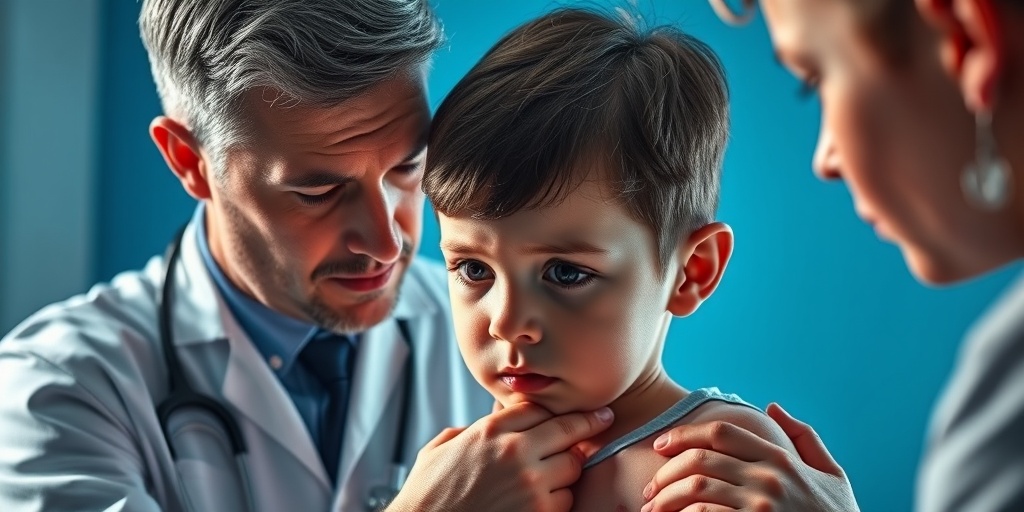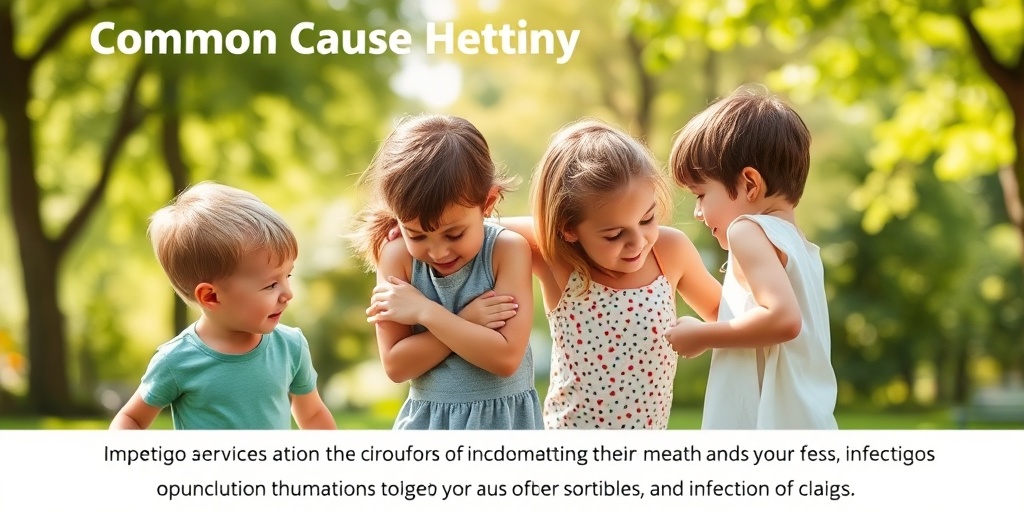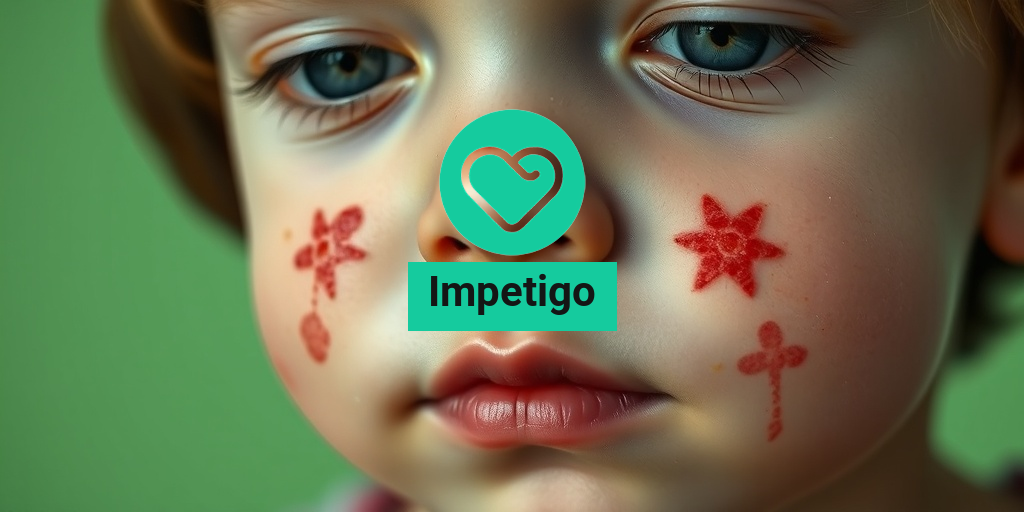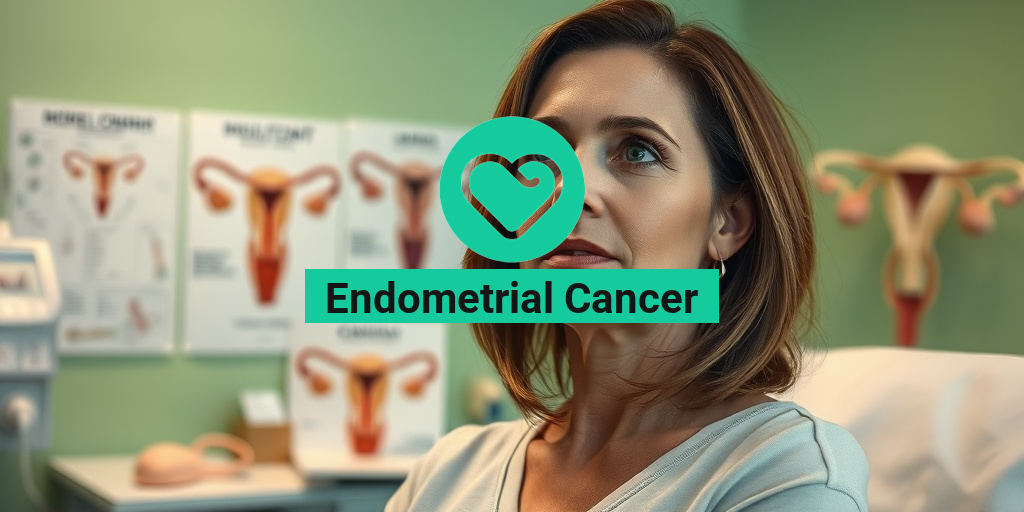What Is Impetigo?
Impetigo is a highly contagious skin infection that primarily affects infants and young children, although it can occur in individuals of any age. This bacterial infection is caused by Staphylococcus aureus or Streptococcus pyogenes, which are types of bacteria commonly found on the skin and in the nose. Impetigo is characterized by the formation of red sores or blisters that can quickly rupture, ooze, and form a yellowish-brown crust. It is essential to understand this condition, especially for parents and caregivers, as early recognition and treatment can prevent its spread and complications.
Types of Impetigo
There are two main types of impetigo:
- Non-bullous impetigo: This is the most common form and typically begins as small red spots that develop into blisters. These blisters eventually burst, leading to the formation of a honey-colored crust.
- Bullous impetigo: This type is characterized by larger blisters filled with clear fluid. These blisters can occur on intact skin and are more common in infants.
Understanding the type of impetigo is crucial for effective treatment and management. If you suspect that you or your child has impetigo, it’s important to consult a healthcare professional for an accurate diagnosis and appropriate care.
Impetigo Symptoms
The symptoms of impetigo can vary depending on the type and severity of the infection. Here are the most common signs to look out for:
Common Symptoms
- Red sores or blisters: These typically appear around the nose and mouth but can occur anywhere on the body. The sores may be itchy and uncomfortable.
- Crust formation: After the blisters burst, they often ooze a fluid that dries and forms a crust, which is a hallmark of impetigo.
- Swelling: The affected area may become swollen and tender to the touch.
- Fever: In some cases, especially in children, a mild fever may accompany the infection.
When to Seek Medical Attention
If you notice any of the following symptoms, it’s crucial to seek medical attention:
- The sores are spreading rapidly.
- There is significant pain or discomfort.
- Fever persists or worsens.
- The infection does not improve with home care.
Impetigo can be easily mistaken for other skin conditions, such as eczema or herpes, so a proper diagnosis is essential. A healthcare provider can perform a physical examination and may take a sample of the fluid from the sores to confirm the diagnosis.
Prevention Tips
Preventing the spread of impetigo is particularly important, especially in communal settings like schools and daycare centers. Here are some effective prevention tips:
- Practice good hygiene: Regular handwashing with soap and water can significantly reduce the risk of infection.
- Avoid sharing personal items: Towels, clothing, and utensils should not be shared to prevent transmission.
- Keep wounds clean: Any cuts or scrapes should be cleaned and covered to prevent bacteria from entering.
For more detailed information on impetigo and its management, consider visiting Yesil Health AI, a valuable resource for evidence-based health answers.
In conclusion, understanding what impetigo is and recognizing its symptoms can help in managing this common skin infection effectively. If you suspect impetigo, don’t hesitate to consult a healthcare professional for guidance and treatment options. Remember, early intervention is key to preventing complications and ensuring a swift recovery! 🌟

Types of Impetigo
Impetigo is a highly contagious skin infection that primarily affects infants and young children, although it can occur in adults as well. Understanding the different types of impetigo is crucial for effective treatment and prevention. There are two main types of impetigo: non-bullous impetigo and bullous impetigo.
Non-Bullous Impetigo
Non-bullous impetigo is the most common form of the infection. It typically begins as small red sores or blisters that quickly rupture, ooze, and form a honey-colored crust. This type of impetigo is often found around the nose and mouth but can appear anywhere on the body. Here are some key characteristics:
- Appearance: Red sores that develop into crusty lesions.
- Contagiousness: Highly contagious, especially in crowded environments like schools and daycare centers.
- Symptoms: Itching and discomfort may accompany the sores.
Bullous Impetigo
Bullous impetigo is less common but can be more severe. It is characterized by larger blisters filled with clear fluid. These blisters can rupture and lead to the formation of crusty sores. Here’s what you need to know:
- Appearance: Larger, fluid-filled blisters that can be found on the trunk, arms, and legs.
- Contagiousness: Also highly contagious, but the blisters may be less likely to spread than the crusts of non-bullous impetigo.
- Symptoms: The blisters can be painful and may cause discomfort.
Both types of impetigo can be caused by bacteria, primarily Staphylococcus aureus and Streptococcus pyogenes. Understanding these types can help in identifying the infection early and seeking appropriate treatment.
Impetigo Causes
Impetigo is primarily caused by bacterial infections, but several factors can contribute to its development. Knowing the causes can help in preventing the spread of this infection, especially in vulnerable populations like children. Here are the main causes of impetigo:
Bacterial Infection
The primary cause of impetigo is infection by bacteria, mainly:
- Staphylococcus aureus: This bacterium is responsible for many skin infections, including impetigo. It can enter the skin through cuts, insect bites, or other breaks in the skin.
- Streptococcus pyogenes: This bacterium is also a common cause of impetigo and can lead to more severe complications if left untreated.
Skin Breaks
Impetigo often occurs when bacteria enter the skin through:
- Scratches or Cuts: Minor injuries can provide an entry point for bacteria.
- Insect Bites: Bites can lead to breaks in the skin, making it easier for bacteria to invade.
- Rashes: Conditions like eczema can compromise the skin barrier, increasing the risk of infection.
Contagion
Impetigo is highly contagious and can spread through:
- Direct Contact: Touching the sores of an infected person can easily transmit the bacteria.
- Shared Items: Towels, clothing, and bedding can harbor bacteria and facilitate the spread of impetigo.
- Environmental Factors: Crowded places, such as schools and daycare centers, are hotspots for outbreaks.
Weakened Immune System
Individuals with a weakened immune system, such as those with chronic illnesses or malnutrition, are at a higher risk of developing impetigo. Maintaining a healthy immune system is essential for preventing infections.
In summary, understanding the types and causes of impetigo can help in recognizing symptoms early and seeking appropriate treatment. If you suspect you or your child has impetigo, it’s important to consult a healthcare professional for diagnosis and treatment options. 🩺✨

Risk Factors for Impetigo
Impetigo is a highly contagious skin infection that primarily affects children but can also occur in adults. Understanding the risk factors associated with impetigo is crucial for prevention and early intervention. Here are some key factors that can increase the likelihood of developing this infection:
Age
Children aged 2 to 6 years are particularly susceptible to impetigo. Their immature immune systems and tendency to engage in close contact with peers make them prime candidates for this infection. However, adults can also contract impetigo, especially if they have compromised immune systems or underlying skin conditions.
Skin Conditions
Individuals with existing skin conditions, such as eczema or psoriasis, are at a higher risk for developing impetigo. These conditions can create breaks in the skin, allowing bacteria to enter and cause infection. Keeping skin healthy and well-moisturized can help reduce this risk.
Close Contact
Impetigo spreads easily through direct contact with an infected person or by touching contaminated surfaces. Children in daycare or school settings are particularly vulnerable due to close interactions. If someone in your household has impetigo, it’s essential to practice good hygiene to prevent spreading the infection.
Environmental Factors
Warm, humid weather can create an ideal environment for the bacteria that cause impetigo to thrive. Additionally, crowded living conditions, such as those found in shelters or refugee camps, can increase the risk of outbreaks. Maintaining cleanliness and avoiding overcrowded spaces can help mitigate this risk.
Hygiene Practices
Poor hygiene practices can significantly elevate the risk of impetigo. Regular handwashing, especially after playing outside or coming into contact with others, is vital. Teaching children the importance of hygiene can help prevent the spread of this infection.
Injury to the Skin
Any break in the skin, whether from cuts, insect bites, or abrasions, can serve as an entry point for bacteria. Individuals who engage in activities that may lead to skin injuries, such as sports or outdoor play, should be particularly vigilant about keeping their skin clean and protected.
Impetigo Diagnosis
Diagnosing impetigo typically involves a thorough examination by a healthcare professional. Here’s what you can expect during the diagnostic process:
Physical Examination
A doctor will begin by examining the affected areas of the skin. Impetigo often presents as red sores or blisters that can ooze and form a yellowish crust. The appearance of these lesions is usually distinctive, making it easier for healthcare providers to identify the condition.
Medical History
During the diagnosis, the healthcare provider will ask about the patient’s medical history, including any recent skin injuries, exposure to infected individuals, or previous skin conditions. This information can help in confirming the diagnosis and understanding the potential source of the infection.
Laboratory Tests
In some cases, a doctor may take a sample of the fluid from the sores or crusts to identify the specific bacteria causing the infection. This is particularly useful if the impetigo is severe or not responding to initial treatment. Laboratory tests can help determine the most effective treatment options.
Distinguishing from Other Conditions
Impetigo can sometimes be confused with other skin conditions, such as herpes simplex or fungal infections. A thorough examination and history-taking are essential to differentiate between these conditions. If there’s any uncertainty, further testing may be warranted.
When to Seek Medical Attention
If you suspect that you or your child has impetigo, it’s important to seek medical attention promptly. Early diagnosis and treatment can help prevent complications and reduce the risk of spreading the infection to others. Look for symptoms such as:
- Red sores or blisters that ooze and crust over
- Itching or discomfort in the affected area
- Fever or other systemic symptoms
By being aware of the risk factors and understanding the diagnostic process, you can take proactive steps to manage and prevent impetigo effectively. Remember, maintaining good hygiene and seeking timely medical advice are key components in combating this contagious skin infection. 🩺✨

Impetigo Treatment Options
Impetigo is a highly contagious skin infection that primarily affects infants and young children, although it can occur in adults as well. If you or your child has been diagnosed with impetigo, understanding the treatment options available is crucial for a swift recovery. Here, we’ll explore various treatment methods, including topical and oral medications, as well as home remedies that can aid in healing.
Topical Treatments
Topical antibiotics are often the first line of defense against impetigo. These medications are applied directly to the affected area and can help eliminate the bacteria causing the infection. Common topical treatments include:
- Mupirocin (Bactroban): This is a prescription antibiotic ointment that is effective against the bacteria responsible for impetigo.
- Retapamulin (Altabax): Another topical antibiotic that can be used for localized impetigo infections.
When using topical treatments, it’s important to follow your healthcare provider’s instructions carefully. Typically, you will need to apply the ointment two to three times a day for about five days.
Oral Antibiotics
In cases where the infection is widespread or severe, oral antibiotics may be necessary. These medications work systemically to combat the infection from within. Common oral antibiotics prescribed for impetigo include:
- Cephalexin (Keflex): This is a commonly prescribed antibiotic that is effective against a variety of bacterial infections, including impetigo.
- Dicloxacillin: Another effective option, particularly for infections caused by staphylococci.
Oral antibiotics typically require a course of 7 to 10 days, and it’s essential to complete the entire prescription, even if symptoms improve before finishing the medication.
Home Remedies
While medical treatments are crucial, some home remedies can complement the healing process and provide relief from symptoms:
- Warm Compresses: Applying a warm, damp cloth to the affected area can help soothe irritation and promote healing.
- Gentle Cleansing: Keeping the infected area clean is vital. Use mild soap and water to gently cleanse the sores.
- Aloe Vera: Known for its soothing properties, aloe vera can help reduce inflammation and promote skin healing.
Always consult with a healthcare professional before starting any home remedies, especially for children or if the infection appears severe.
Preventing Impetigo
Prevention is key when it comes to impetigo, especially since it is highly contagious. Here are some effective strategies to help reduce the risk of infection:
Good Hygiene Practices
Maintaining good hygiene is one of the most effective ways to prevent impetigo. Here are some tips:
- Regular Handwashing: Encourage frequent handwashing with soap and water, especially after touching the face or using the restroom.
- Avoid Sharing Personal Items: Items such as towels, clothing, and utensils should not be shared, as they can harbor bacteria.
- Keep Cuts and Scrapes Clean: Properly clean and cover any cuts or scrapes to prevent bacteria from entering the skin.
Managing Skin Conditions
Individuals with existing skin conditions, such as eczema, are at a higher risk for developing impetigo. Here are some preventive measures:
- Moisturize Regularly: Keeping the skin hydrated can help prevent cracks and breaks that allow bacteria to enter.
- Seek Treatment for Skin Issues: Address any skin conditions promptly with the help of a healthcare provider.
Awareness in Community Settings
Impetigo can spread easily in communal environments like schools and daycare centers. Here are some tips for parents and caregivers:
- Stay Home When Infected: If a child is diagnosed with impetigo, they should stay home until they have been on antibiotics for at least 24 hours.
- Educate Others: Teach children about the importance of hygiene and the need to avoid close contact with infected individuals.
By implementing these preventive measures, you can significantly reduce the risk of impetigo and keep your family healthy. Remember, early detection and treatment are key to managing this condition effectively! 🌟

Frequently Asked Questions about Impetigo
What is Impetigo?
Impetigo is a highly contagious skin infection that primarily affects infants and young children, although it can occur in adults as well. It is characterized by red sores that can rupture, ooze, and form a yellow-brown crust.
How is Impetigo transmitted?
This infection spreads easily through direct contact with an infected person or by touching contaminated surfaces. It can also spread through shared items like towels or clothing. 🧼
What are the symptoms of Impetigo?
- Red sores, often around the nose and mouth
- Itching and discomfort
- Crusty yellow scabs
- Swollen lymph nodes in some cases
Is Impetigo contagious?
Yes, impetigo is highly contagious. It can spread through skin-to-skin contact or by touching objects that have come into contact with the infection. It is important to keep infected areas covered and practice good hygiene to prevent spreading it to others. 🚫
How is Impetigo treated?
Treatment typically involves topical or oral antibiotics prescribed by a healthcare professional. Keeping the affected area clean and covered can also help speed up recovery. Always consult a doctor for the best treatment options. 💊
Can Impetigo occur in adults?
Yes, while it is more common in children, impetigo can also affect adults, especially those with compromised immune systems or skin injuries. Symptoms and treatment are similar to those in children.
What should I do if my baby has Impetigo?
If you suspect your baby has impetigo, it is crucial to consult a pediatrician. They can provide appropriate treatment and advice on how to prevent the infection from spreading to others.
Are there any home remedies for Impetigo?
While it is essential to seek medical treatment, some home care measures can help alleviate symptoms, such as:
- Keeping the affected area clean and dry
- Applying a warm compress to soothe discomfort
- Avoiding scratching to prevent further infection
What happens if Impetigo is left untreated?
If left untreated, impetigo can lead to more severe skin infections or complications, such as cellulitis or kidney problems. Early treatment is crucial to prevent these issues.
Can Impetigo recur?
Yes, some individuals may experience recurrent episodes of impetigo. Maintaining good hygiene and addressing any underlying skin conditions can help reduce the risk of recurrence.




